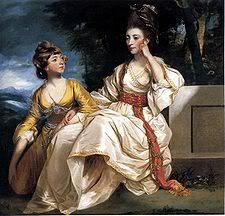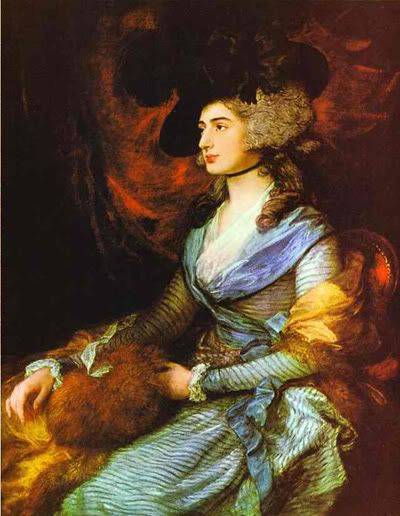Fashion in Reynolds and Gainsborough: Part 8
1:49 PMPart 1
Part 2
Part 3
Part 4
Part 5
Part 6
Part 7
One connection in the dress of the sitters for both Reynolds and Gainsborough was the exotic references both painters often used. Orientalism was all the rage in the eighteenth century, and in particular Turkish styles permeated fashion. The robe a la turque was a highly fashionable and popular appropriation of Turkish dress. Lady Mary Wortley Montagu described Turkish costume in the eighteenth century when she traveled abroad:
“The first part of my dress is a pair of drawers, very full that reach to my shoes, and conceal the legs more modestly than your petticoats… Over this hangs my smock, of a fine white silk gauze, edged with embroidery. This smock has wide sleeves hanging halfway down the arm, and is closed at the neck with a diamond button… The antery is a waistcoat, made close to the shape, of white and gold damask, with very long sleeves falling back, and fringed with deep gold frienge… My caftan, of the same stuff with my drawers, is a robe exactly fitted to my shape, and reaching to my feet, with very long strait falling sleeves. Over this is my gridle, of about four fingers broad, which, all that can afford it, have entirely diamonds and other precious stones…”
In assuming this foreign style, the wearer implies that they are well traveled and knowledgeable of cultures other than their own.

In his painting Mrs Hester Lynch Thrale with her Daughter Hester Maria from 1777-8, Reynolds brings elements of Turkish dress into his traditional classical drapery. Like Reynolds’ other sitters, Mrs. Thrale is dressed in a made up costume that calls to mind both classical civilizations and the silhouette of contemporary fashion. Yet her gown is made of a lustrous silk, bordered with a zig-zag and polkadot pattern done in gold embroidery, calling to mind both the wealth and an interpretation of the visual aesthetic of the east. Around her waist is a bright red sash, trimmed with gold and heavy fringe, which drapes lightly to the floor and is clearly an echo of a kuşak, the waist girdle worn in Turkish costume. Her whole costume is carries many elements similar to the ones described by Lady Montagu. Although there is nothing in the landscape to suggest an oriental locale, Mrs. Thrale is clearly aligning herself with the exoticism and excitement of a foreign world. However, she also aligns herself with the height of western fashion with the combination of her fashionable tall hairstyle and the trend for Turkish styles.

Gainsborough’s portrait of Sarah Siddons, entitled Mrs. Siddons and dating from c. 1783-85, also indulges in an orientalist Turkish fantasy, although his version is more within the current trends of western fashion. Mrs. Siddons wears a blue and white striped wrap gown of the very latest style with a blue sash around her waist, a picture hat like the one worn by the Duchess of Devonshire, and is wrapped in a cloak lined with fur and carries a fur muff. As a famous actress, Mrs. Siddons could afford to wear the latest styles and surround herself with luxuries like fur, thus she wished to show this symbol of wealth and power off in her portrait. Henry Bates described the portrait, saying
“The resemblance is admirable, and the features are without the theatrical distortion which several painters have been fond of delineating. In addition to the great force and likeness which the portrait possesses, the new style of drapery might be mentioned. Mrs. Siddons’s dress is particularly novella, and the fur around her cloak and fox-skin muff are most happy imitations of nature.”
The style of wrapped dress, along with the striped design, is influenced by anteri- the robe worn in Turkish dress, showing her connection with the exotic as well as with the latest trends.
Whether Gainsborough’s foray into orientalist Turkish fashion is more or less of a fantasy than Reynolds’ is up for debate. The gown painted by Gainsborough is clearly a western style, something which could be seen walking down the street or in a fashionable park. The clothing of Reynolds’ sitter, on the other hand, is clearly a fantasy costume meant to invoke both Turkish and classical societies. The costume-like nature of the dress in Reynolds’ painting could indicate a greater accuracy, yet it also brings in elements of other cultures and could be just as contrived as the western appropriation of Turkish costume seen in Gainsborough’s painting. What is most important is the different expressions of orientalist fantasy. In Reynolds’ work, the costume-like nature of the garment and the non-specificity of the background places the sitter within an orientalist fantasy world, giving her the attributes of the western fantasy of a beautiful Turkish lady. Gainsborough’s painting, on the other hand, shows distinctly western trends throughout, placing the sitter within her own modern, local context and showing her to be an exotic lady but still a contemporary lady of eighteenth century London.



0 comments